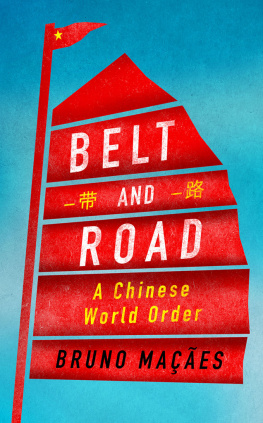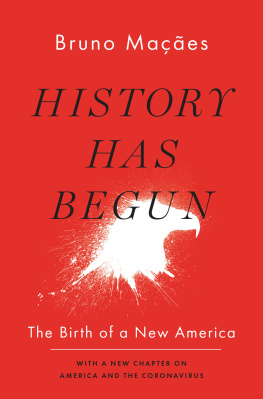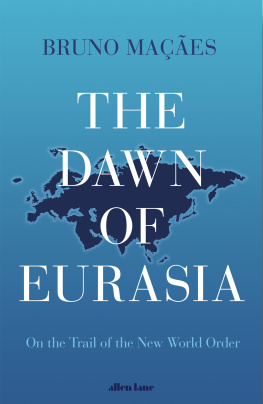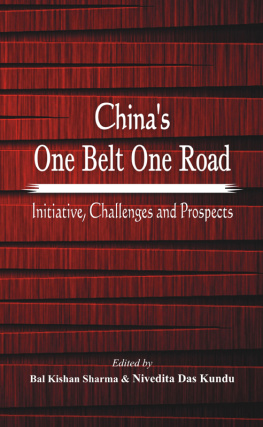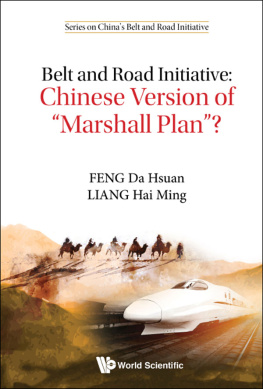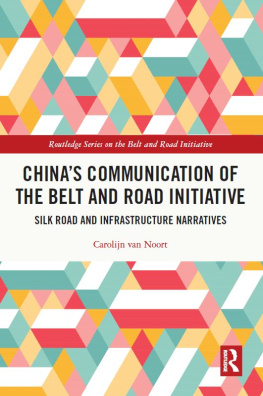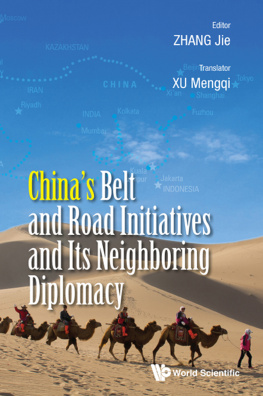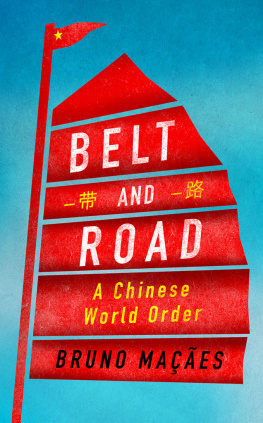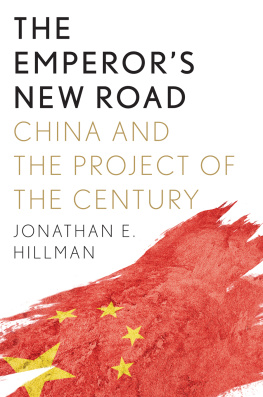BRUNO MAES
Belt and Road
A Chinese World Order

HURST & COMPANY, LONDON
First published in the United Kingdom in 2018 by
C. Hurst US & Co. (Publishers) Ltd.,
41 Great Russell Street, London, WC1B 3PL
Bruno Maes, 2019
All rights reserved.
Distributed in the United States, Canada and Latin America by Oxford University Press, 198 Madison Avenue, New York, NY 10016, United States of America.
The right of Bruno Maes to be identified as the author of this publication is asserted by him in accordance with the Copyright, Designs and Patents Act, 1988.
A Cataloguing-in-Publication data record for this book is available from the British Library.
ISBN: 978-1-7873-8183-4
www.hurstpublishers.com
CONTENTS
INTRODUCTION
THE GREAT MAP OF MANKIND
When J.R.R. Tolkien was asked by a reader how he had approached the composition of The Lord of the Rings, a book that took twelve years to write and spans more than a thousand pages, he answered: I wisely started with a map and made the story fit. So it is. When imagining new worlds we often start with a map.
For seventy years, our map of world politics was organized in a certain way. The center of global political and economic power came to be located in the United States, from where it radiated to the maritime edges of the large Eurasian supercontinenta kind of forward deployment against the dangers emanating from its inner core. Western Europe and parts of East Asia were seen as natural extensions of American power, aligned with Washington in values and goals and enjoying significant autonomy from their senior partner. Inevitably, the large landmass of Eurasia remained divided into two areas, according to the path of historical development they had embarked upon: the Western path, to be replicated in countries such as Japan and South Korea, and an alternative path and ideal, defined in different measures and in different ways by Moscow and Beijing, about which there was much less clarity and unity and which sometimes meant little more than the negation of the former.
What took observers by surprise was not that the Eurasian supercontinent emerged from the Cold War as an increasingly integrated space, but that it became so not according to a Western model, but rather as the stage for many different and conflicting political ideas.
The new map of world politics is radically different from the previous one. The United States has seemingly abandoned any pretension to shape the world in its image. American power is still a force to be reckoned with, but from now on it will be exercised at a distance. Just as the United Kingdom in the nineteenth century lived in a precarious relation of distance and proximity to the continent across the Channel, so does the United States appear today as both a part of Eurasian politics and a separate unit enjoying considerable autonomy and independence.
At the same time, new powers have been emerging in Asia that can no longer be seen as pale or imperfect copies of Western society. With the disappearance of the old ideological battle lines and the establishment of new economic links, a new geographic entity started to emerge: Eurasia, the supercontinent extending from Lisbon to Shanghai or even Jakarta. One could argue if this is a return to an older time or the dawn of a new age. The latter would be more exact: romantic images of the Silk Road or Marco Polos adventures cannot hide the fact that trade along those routes was insignificant and almost no one made the whole journey from sea to sea. As for Genghis Khan, practically limitless as his empire was to become, it quickly broke apart into separate units, prefigurations of future states or empires.
As we list the main centers of influence bringing Eurasia together, pride of place must be given to China and its major geopolitical project, the Belt and Road. In our map it should appear as nine arrows crisscrossing Eurasia in all directions: six economic corridors on land and three sea routes whose final goal is to create a new global economy and place China at its center. Eurasian trade in goods is now close to $2 trillion each year, consistently more than double the volume of Transatlantic trade and significantly more than Transpacific trade. This is all the more remarkable as this is the axis of the world economy where physical and legal restrictions are most significant and therefore where the potential for growth is the highest. After trade, financial flows will inevitably follow and then cultural and political influence. Whoever is able to build and control the infrastructure linking the two ends of Eurasia will rule the world.
But the Belt and Road is only part of the story. If you want to draw an accurate map of Eurasia you need to add the gradual expansion of Indian power from the Suez Canal to Malacca. Both the Portuguese and the British thought that India encompassed the whole of the Indian Ocean region and this is increasingly how decision-makers in Delhi see the question of Indias place in the world. In the next few years we shall see them focused on building a powerful navy and opening military bases in the Horn of Africa and Sumatra, while attempting to integrate the densely populated Indian littoral into its own economic value chains. Raja Mohan, a prominent Indian foreign policy analyst, has argued that the Indian political and policy establishment, long brought up on the notion that Europe and Asia are different, must adapt to their slow but certain integration into a single geopolitical theatre.
As for Russia, it now looks in four directions at once, a marked improvement upon the double-headed eagle of its state emblem. Traditionally, Russian elites tended to see their task as that of bringing about a gradual but complete integration with a more advanced Europe. That vision is now being replaced by a new self-image: as the center and core of the Eurasian supercontinent, Russia can reach in all directions and provide a bridge between Europe and China on both ends. Vladislav Surkov, a trusted advisor to President Putin, recently argued that Russia is a Western-Eastern half-breed nation, with its double-headed statehood, hybrid mentality, intercontinental territory and bipolar history. In fact Moscow is also looking south to the Middle East, hoping to acquire control over all the main regions of energy production, and to the north, as global warming transforms the Arctic into an important trade route linking Europe and Asia.
Eurasia is becoming smaller, more integrated, the stage for intense rivalry and competition between different poles, each of them projecting influence outwards and creating new connections. Japan is financing and building infrastructure across the Indian Ocean, all the way to Djibouti, an initiative to which it has dedicated $250 billion. Iran will not rest until it is able to carve a land corridor to the Mediterranean, something it has been deprived of since the Sassanian Shahs 1,400 years ago. Turkey now acts independently of its Western partners and has started to relish the status of a Middle Eastern country, in the process bringing that troubled region to the very borders of the European Union.
Europe has its own strategy too, although it is far from a conscious one. It consists of creating little Europes all over the supercontinent: small classes of people in all major metropoles who mimic the European way of life, individualistic and cosmopolitan, connected in tight networks and sharing a similar ethos and common economic and cultural projects. Our map needs to include this spider web of cosmopolitan neighborhoods in Istanbul, Moscow, Mumbai, Shanghai and many other places.
Next page
